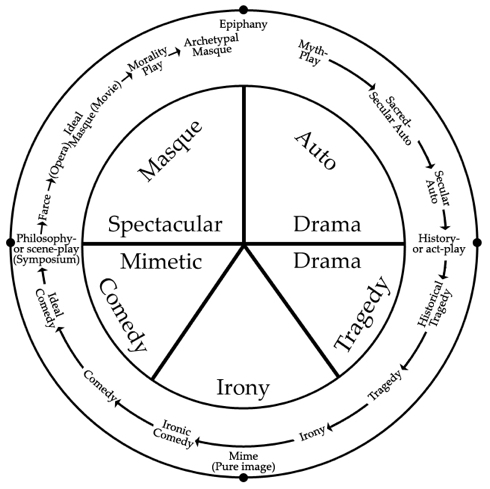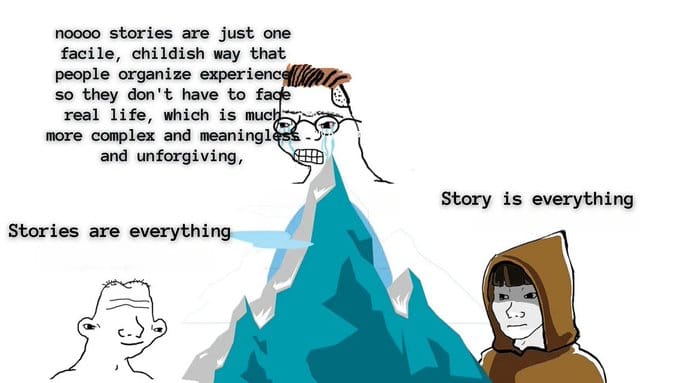Northrop Frye on the Romance

Specific Modes of Drama from Northrop Frye’s Anatomy of Criticism
Following my online mentor John J. Reilly, I often refer to Northrop Frye’s Anatomy of Criticism when I write about stories. It is useful to have another point of reference for talking about the modes and structure of stories than Joseph Campbell, whose Hero’s Journey is the only kind of story structure many people have heard of.
However, despite John saying in his review of Anatomy of Criticism that it should be a diagram instead of text, John didn’t provide any diagrams or figures. Thankfully, Robert D. Denham has a wonderful webpage about Northrop Frye full of the missing diagrams.
What follows is taken from Denham’s website, as Denham captured something interesting that I want to emphasize. The distinction between the novel and the romance has been mostly lost, in part because of a successful campaign by literary critics to cast the novel as high art and the romance as low art.
Today, “serious” novels, sometimes also referred to as literary fiction, embody what is seen as worthy of serious consideration, while genre fiction, the successor to the romance, is not. Frye wasn’t content to let that stand, and neither am I.
The essential difference between novel and romance,” says Frye, “lies in the conception of characterization” (AC, 304). He illustrates this by setting down a series of opposing qualities which are said respectively to characterize the two forms:
{113}The romancer does not attempt to create “real people” so much as stylized figures which expand into psychological archetypes. It is in the romance that we find Jung’s libido, anima, and shadow reflected in the hero, heroine, and villain respectively. That is why romance so often radiates a glow of subjective intensity that the novel lacks, and why a suggestion of allegory is constantly creeping in around its fringes. Certain elements of character are released in the romance which make it naturally a more revolutionary form than the novel. The novelist deals with personality, with characters wearing their personae or social masks. He needs the framework of a stable society, and many of our best novelists have been conventional to the verge of fussiness. The romancer deals with individuality, with characters in vacuo idealized by revery, and, however conservative he may be, something nihilistic and untamable is likely to keep breaking out of his pages. (AC, 304–5)
…
The claims that Frye makes for generic criticism of the variety just outlined are more directly stated in this section than in the one on drama. He himself asks what function is served by the distinction, say, between novel and romance, especially when, as he has argued, there are few “pure” forms of either. His answer is that a writer “should be examined in terms of the conventions he chose” (AC, 305), an answer directed especially toward the novel-centered view of prose fiction. Frye makes this point several times; perhaps it is best expressed in the following passage:
William Morris should not be left on the side lines of prose fiction merely because the critic has not learned to take the romance form seriously. Nor, in view of what has been said about the revolutionary nature of the romance, should his choice of that form be regarded as an “escape” from his social attitude. If Scott has any claims to be a romancer, it is not good criticism to deal only with his defects as a novelist. The romantic qualities of The Pilgrim’s Progress, too, its archetypal characterization and its {117}revolutionary approach to religious experience, make it a well-rounded example of a literary form: it is not merely a book swallowed by English literature to get some religious bulk in its diet. Finally, when Hawthorne, in the preface to The House of the Seven Gables, insists that his story be read as romance and not as novel, it is possible that he meant what he said, even though he indicates that the prestige of the rival form has induced the romancer to apologize for not using it. (AC, 305–6)
The plea here, in part, is for a less provincial attitude, for an ecumenical perspective which does not relegate some forms of prose, like the confession, to that “vague limbo of books which are not quite literature because they are ‘thought,’ and not quite religion or philosophy because they are Examples of Prose Style” (AC, 307)

Comments ()